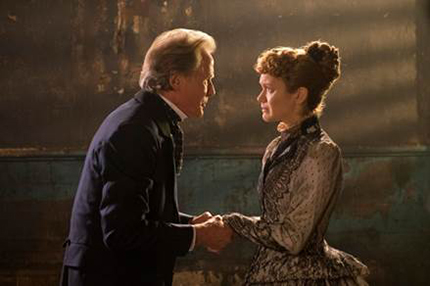Toronto 2016 Review: THE LIMEHOUSE GOLEM, A Giallo-Infused Theatre of Bedlam

We might think that in the 21st century, with social media platforms or instant video uploads, we are at the apex of what might be called the theatricality of life in the public eye. But even if Twitter didn't exist, people in the 19th century still craved gossip about murder and sex, still lead so-called depraved lives, and all this was on display for ready consumption by a public craving all that would make them able to look down upon others. Especially if those others were women, gay, or Jewish. In his second feature, director Juan Carlos Medina brings the music halls and gruesome murders of 19th century London to spectacular life in The Limehouse Golem.
Based on the epistolary novel by Peter Ackroyd, a serial killer is plaguing the streets of London in the late 19th century. Meanwhile, Elizabeth Cree (Olivia Cooke), a former music hall performer, is charged with the murder of her husband. Detective Kildare (Bill Nighy) must tackle both these cases, learning about Elizabeth's strange life, her relationship with fellow performer Dan Leno (Douglas Booth), and the beliefs of the locals of Limehouse that a fabled Yiddish monster is to blame for the killings. In his investigation, he encounters music hall performers, prostitutes, Karl Marx, and a labyrinthian tale of murder and mayhem.
The film opens on Leno as he introduces the tale, as means of indicated to the audience that all is a matter of public display. Moving from music hall to dressing room to police headquarters to the dirty streets of Limehouse, Medina frames his characters frequently, and literally, in doorways, mirrors, between pillars, in windows with the anxious and insatiable public looking on. To remain hidden or private is a luxury not afforded anyone but the most clever. The often-present red tones are not of love, but sex, passion, and blood; but the ever-present green infuses the film with its barely-hidden undertones of jealousy and rage. And shadow is also frequently invoked on the faces of the characters; even in the theatre, there must be an air of mystery.
This is no quaint and respectful BBC costume drama. Medina seamlessly mixes this Victorian-era tale with an eye for the properly gruesome normally found in Giallo-style film, while at the same time finding the style of the theatre of the era, in which exagerration and pantomime were the norm. For this is not the city of Charles Dickens; this is the other London, where those rejected (either openly or subtely) either found solace in each other or found ... shall we say, other means of expression. Cross-dressing, homosexuality, those not of the 'accepted' faiths, all found their place (either willingly or unwillingly) as actors in this bizarre theatre for the masses.
Of course, this is still a murder mystery, and it's exciting to follow Kildaire and his assistant Flood as they try to find the Golem in his human form (there are no murder-mysteries quite like British ones). A fantastic script by Jane Goldman (indeed, her finest one to date) gives even expository dialogue necessary for such a story, weight and frequent dark humour. Production designer Grant Montgomery (the man behind the look of Peaky Blinders) does not make the grittiness of life in these slums tidy, nor the music halls refined. This world is filthy, sweaty, harsh and frequently cruel. The meticulous recrreation is stunning, not least of which in the incredible musical hall scenes, where the bawdy (and oddly sophisticated) humour and song gives clues to the story.
Occupying this world are some colourful characters, and behind them are powerful acting forces. As the detective trying to solve both cases, Nighy occupies the centre of the story, but he keeps his performance tight and economical, as fits his role; subtlety and determination mark both the character's professional and personal life. Douglas Booth gives Leno both an appropriately Joel-Grey-Cabaret style dramatic flair, but hints at the darker forces that make Leno both something of a mystery and an actor for the downtrodden lower classes. Fabulous turns by Eddie Marsan and María Valverde add colour and dimension to the music hall world.
But this film belongs to Olivia Cooke. Her Elizabeth is a young woman ahead of her time, unable to reconcile her intelligence and desire for independence with a society that insists on putting her in her place as a woman (how little has changed). She refuses to play to male fantasies (instead she creates her own), and for that she is continually punished. Cooke never wavers in her presentation of Elizabeth, in her cunning and vulnerability.
If I have a criticism, it's that the editing was often a bit too quick; there are many glorious shots that were cut short when they should lingered, and this would also allowed the audience a moment to catch their breath. Perhaps this was in the interest of running time, so fingers crossed for a director's cut. The Limehouse Golem is a wonderfully frenetic and rich tale, and welcome change to the usual costume dramas we've come to expect with such material.
The Limehouse Golem
Director(s)
- Juan Carlos Medina
Writer(s)
- Jane Goldman (screenplay)
- Peter Ackroyd (based on the novel by)
Cast
- Douglas Booth
- Olivia Cooke
- Sam Reid
- María Valverde







